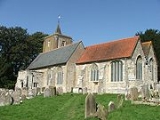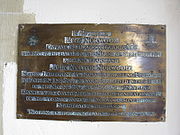
St Michael's Church, East Peckham
Encyclopedia
St Michael's is a redundant
Anglican church in East Peckham
, Kent
, England
. The Grade II* listed church is in the care of the Churches Conservation Trust
and open to the public.
. A church was in existence at the time of Domesday. The earliest surviving parts of the existing church are the north walls of the nave
and chancel
, which are of mid C12th date. The church at this time comprised the nave and a short chancel. The chancel was extended in the late C12th. By the mid C13th the south aisle had been built. In the late 13th century, a chapel
dedicated to the Virgin Mary
had been built to the east of the south aisle and south of the chancel. The tower
was added in the early C14th and the porch
in c1500 The tower formerly carried a much taller spire
than the current smaller spirelet. It was destroyed in a storm in 1704. The weathervane dates from 1928 and is a copy of the one erected in 1704. The remains of a sundial
can be seen on the porch, it fell into disuse when a clock
was installed in the church.
The vestry was added in the early C19th. The church was restored
by the Victorians in 1853 and 1863. St Michael's was listed in 1959, and it was declared redundant in 1973.
hung for change ringing
. The oldest (the fifth heaviest of the ring) was cast in 1747 by Robert Catlin. Two (the second and third heaviest) were cast in 1785 by William Mears of the Whitechapel Bell Foundry
. The heaviest (the sixth, usually called the tenor) was cast in 1812 and the lightest (the first, usually called the treble) was cast in 1825 by Thomas Mears II and the remaining bell (the fourth heaviest) was cast in 1890, by Mears & Stainbank (all successors to Wiliam Mears at Whitechapel).
 St Michael's has a number of memorials, including those to:-
St Michael's has a number of memorials, including those to:-
Redundant church
A redundant church is a church building that is no longer required for regular public worship. The phrase is particularly used to refer to former Anglican buildings in the United Kingdom, but may refer to any disused church building around the world...
Anglican church in East Peckham
East Peckham
East Peckham is a village in Kent, England, made up of nine hamlets and situated about east of Tonbridge on the River Medway. It was the centre for the hop growing industry in Kent and is still home to the Hop Farm which has the world's largest collection of Oast Houses.-History:The Domesday entry...
, Kent
Kent
Kent is a county in southeast England, and is one of the home counties. It borders East Sussex, Surrey and Greater London and has a defined boundary with Essex in the middle of the Thames Estuary. The ceremonial county boundaries of Kent include the shire county of Kent and the unitary borough of...
, England
England
England is a country that is part of the United Kingdom. It shares land borders with Scotland to the north and Wales to the west; the Irish Sea is to the north west, the Celtic Sea to the south west, with the North Sea to the east and the English Channel to the south separating it from continental...
. The Grade II* listed church is in the care of the Churches Conservation Trust
Churches Conservation Trust
The Churches Conservation Trust, which was initially known as the Redundant Churches Fund, is a charity whose purpose is to protect historic churches at risk, those that have been made redundant by the Church of England. The Trust was established by the Pastoral Measure of 1968...
and open to the public.
History
In 961, Queen Ediva the Queen Mother gave the manor of Peckham to the monks of CanterburyCanterbury
Canterbury is a historic English cathedral city, which lies at the heart of the City of Canterbury, a district of Kent in South East England. It lies on the River Stour....
. A church was in existence at the time of Domesday. The earliest surviving parts of the existing church are the north walls of the nave
Nave
In Romanesque and Gothic Christian abbey, cathedral basilica and church architecture, the nave is the central approach to the high altar, the main body of the church. "Nave" was probably suggested by the keel shape of its vaulting...
and chancel
Chancel
In church architecture, the chancel is the space around the altar in the sanctuary at the liturgical east end of a traditional Christian church building...
, which are of mid C12th date. The church at this time comprised the nave and a short chancel. The chancel was extended in the late C12th. By the mid C13th the south aisle had been built. In the late 13th century, a chapel
Chapel
A chapel is a building used by Christians as a place of fellowship and worship. It may be part of a larger structure or complex, such as a church, college, hospital, palace, prison or funeral home, located on board a military or commercial ship, or it may be an entirely free-standing building,...
dedicated to the Virgin Mary
Mary (mother of Jesus)
Mary , commonly referred to as "Saint Mary", "Mother Mary", the "Virgin Mary", the "Blessed Virgin Mary", or "Mary, Mother of God", was a Jewish woman of Nazareth in Galilee...
had been built to the east of the south aisle and south of the chancel. The tower
Bell tower
A bell tower is a tower which contains one or more bells, or which is designed to hold bells, even if it has none. In the European tradition, such a tower most commonly serves as part of a church and contains church bells. When attached to a city hall or other civic building, especially in...
was added in the early C14th and the porch
Porch
A porch is external to the walls of the main building proper, but may be enclosed by screen, latticework, broad windows, or other light frame walls extending from the main structure.There are various styles of porches, all of which depend on the architectural tradition of its location...
in c1500 The tower formerly carried a much taller spire
Spire
A spire is a tapering conical or pyramidal structure on the top of a building, particularly a church tower. Etymologically, the word is derived from the Old English word spir, meaning a sprout, shoot, or stalk of grass....
than the current smaller spirelet. It was destroyed in a storm in 1704. The weathervane dates from 1928 and is a copy of the one erected in 1704. The remains of a sundial
Sundial
A sundial is a device that measures time by the position of the Sun. In common designs such as the horizontal sundial, the sun casts a shadow from its style onto a surface marked with lines indicating the hours of the day. The style is the time-telling edge of the gnomon, often a thin rod or a...
can be seen on the porch, it fell into disuse when a clock
Clock
A clock is an instrument used to indicate, keep, and co-ordinate time. The word clock is derived ultimately from the Celtic words clagan and clocca meaning "bell". A silent instrument missing such a mechanism has traditionally been known as a timepiece...
was installed in the church.
The vestry was added in the early C19th. The church was restored
Victorian restoration
Victorian restoration is the term commonly used to refer to the widespread and extensive refurbishment and rebuilding of Church of England churches and cathedrals that took place in England and Wales during the 19th-century reign of Queen Victoria...
by the Victorians in 1853 and 1863. St Michael's was listed in 1959, and it was declared redundant in 1973.
Bells
St Michael's has a ring of six bellsRing of bells
"Ring of bells" is a term most often applied to a set of bells hung in the English style, typically for change ringing...
hung for change ringing
Change ringing
Change ringing is the art of ringing a set of tuned bells in a series of mathematical patterns called "changes". It differs from many other forms of campanology in that no attempt is made to produce a conventional melody....
. The oldest (the fifth heaviest of the ring) was cast in 1747 by Robert Catlin. Two (the second and third heaviest) were cast in 1785 by William Mears of the Whitechapel Bell Foundry
Whitechapel Bell Foundry
The Whitechapel Bell Foundry is a bell foundry in Whitechapel in the London Borough of Tower Hamlets, in the East End of London. The foundry is listed by the Guinness Book of Records as the oldest manufacturing company in Great Britain...
. The heaviest (the sixth, usually called the tenor) was cast in 1812 and the lightest (the first, usually called the treble) was cast in 1825 by Thomas Mears II and the remaining bell (the fourth heaviest) was cast in 1890, by Mears & Stainbank (all successors to Wiliam Mears at Whitechapel).
Memorials

- Richard Etclesley, who died in 1426, bequeathing the gift of a chaliceChalice (cup)A chalice is a goblet or footed cup intended to hold a drink. In general religious terms, it is intended for drinking during a ceremony.-Christian:...
to the church. - The Henham family, who were farmers in East Peckham and propagated the Henham variety of hopHop (plant)Humulus, Hop, is a small genus of flowering plants native to temperate regions of the Northern Hemisphere. The female flowers of H. lupulus are known as hops, and are used as a culinary flavoring and stabilizer, especially in the brewing of beer...
. - John Norwood VCJohn NorwoodCaptain John Norwood VC was an English recipient of the Victoria Cross, the highest and most prestigious award for gallantry in the face of the enemy that can be awarded to British and Commonwealth forces.-Details:...
, who rescued a fallen comrade during the Second Boer WarSecond Boer WarThe Second Boer War was fought from 11 October 1899 until 31 May 1902 between the British Empire and the Afrikaans-speaking Dutch settlers of two independent Boer republics, the South African Republic and the Orange Free State...
under intense enemy fire. - The Twysden family, who owned Roydon Hall, the manor of East Peckham. Sir Roger TwysdenSir Roger Twysden, 2nd BaronetSir Roger Twysden, 2nd Baronet , of Roydon Hall in Kent, was an English historian and politician who sat in the House of Commons at various times between 1625 and 1640.-Life:...
referred in his writings to the family plot at East Peckham church. - The Whetenhall Stones, including those to the second and third wives of Thomas Whetenhall.

